Fear Need not Apply
Let’s demystify the transition from RF engineer to Internet protocol (IP) engineer. We can do so by contrasting and comparing the RF engineer’s hybrid fiber/coax (HFC) network to the IP engineer’s IP network in three specific ways that illustrate key similarities and differences. By mastering these three fundamental concepts, the RF engineer will have a base of knowledge that can be expanded with further education on specific cable services that require IP expertise. Adapting to new technologies Cable engineering has weathered a frantic pace of technology deployment over the last 15 years. Starting with DigiCipher encryption in 1990, multiple technology advances and new services have found their way into most cable systems in North America. Most engineers have been undergoing rapid training on various equipment and software products in order to keep pace with the deployments of new services. Here is a partial list: Based on this impressive track record with complex technologies, cable engineers are good candidates to develop an understanding of IP networks and their applications. Many concepts applied in IP networking are not alien to cable networks, and HFC experts should not be intimidated by IP technology, but should instead draw upon their HFC network expertise to develop a foundation of knowledge on IP networking. Here are three simple steps to take you from HFC to IP: Step 1 The Open System Interconnection (OSI) model from IP networks can be applied to HFC networks. The HFC network that RF engineers are already familiar with can be compared with the layers in an IP network so that the functional separation of these network layers can be easily understood. First, let’s examine the OSI model in order to describe the function of each layer. (See Table 1.) 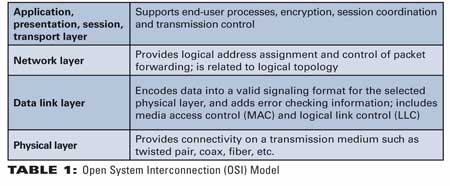 To sum it up more simply, Layer 1 is the physical connectivity, Layer 2 frames up the payload appropriately for the physical media, Layer 3 directs traffic to the correct destination, and the higher layers provide control of the session. Now let’s apply the OSI model to a typical IP network in order to associate these functions with common devices and technologies in IP networks. (See Table 2.)
To sum it up more simply, Layer 1 is the physical connectivity, Layer 2 frames up the payload appropriately for the physical media, Layer 3 directs traffic to the correct destination, and the higher layers provide control of the session. Now let’s apply the OSI model to a typical IP network in order to associate these functions with common devices and technologies in IP networks. (See Table 2.) 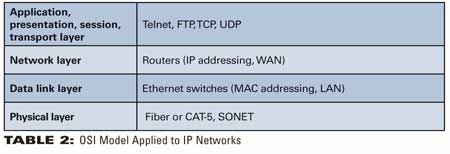 Finally, let’s apply the OSI model to an HFC network. (See Table 3.)
Finally, let’s apply the OSI model to an HFC network. (See Table 3.) 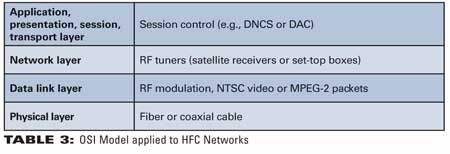 In an HFC network, the physical connectivity is most often supplied by fiber or coaxial cable; the "framing" is done by RF modulation, NTSC video formatting or MPEG-2 encoding; and the "routing" is accomplished by RF tuners, although they generally require manual intervention. Higher layer functions such as application or session control are provided by DNCS or DAC controllers. By examining and categorizing these typical HFC network components and technologies according to the OSI model, you should see that the various functional components of an HFC network are not that dissimilar to devices in an IP network. Step 2 Think fully bidirectional instead of unidirectional broadcast. Traditional HFC networks are generally configured in a unidirectional broadcast architecture—fixed circuit paths for video are established, and the source payload is distributed to all destinations. (See Figure 1.)
In an HFC network, the physical connectivity is most often supplied by fiber or coaxial cable; the "framing" is done by RF modulation, NTSC video formatting or MPEG-2 encoding; and the "routing" is accomplished by RF tuners, although they generally require manual intervention. Higher layer functions such as application or session control are provided by DNCS or DAC controllers. By examining and categorizing these typical HFC network components and technologies according to the OSI model, you should see that the various functional components of an HFC network are not that dissimilar to devices in an IP network. Step 2 Think fully bidirectional instead of unidirectional broadcast. Traditional HFC networks are generally configured in a unidirectional broadcast architecture—fixed circuit paths for video are established, and the source payload is distributed to all destinations. (See Figure 1.) 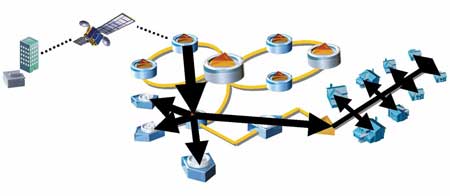 Note: Over time, a reverse path has been added to most HFC networks in the 5-42 MHz frequency range in order to enable interactive services. This asymmetrical, bidirectional capability is utilized, along with communication protocols such as DOCSIS, so that an HFC network can emulate a fully bidirectional network. IP networks are fully bidirectional by nature—the bidirectional capacity is used for both control plane and payload data. Each data packet contains information that identifies both its source and destination, and as long as it is traversing a network that provides a path to its destination, the packet can get there. (See Figure 2.)
Note: Over time, a reverse path has been added to most HFC networks in the 5-42 MHz frequency range in order to enable interactive services. This asymmetrical, bidirectional capability is utilized, along with communication protocols such as DOCSIS, so that an HFC network can emulate a fully bidirectional network. IP networks are fully bidirectional by nature—the bidirectional capacity is used for both control plane and payload data. Each data packet contains information that identifies both its source and destination, and as long as it is traversing a network that provides a path to its destination, the packet can get there. (See Figure 2.) 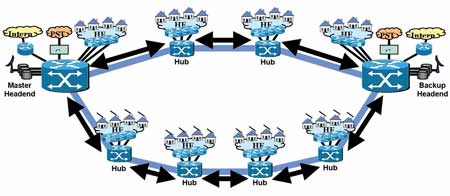 The key to bidirectional networks is that they are useful only if they are connected to many destinations—and in order to connect to many destinations, there must be a strong set of intercommunication standards for the bidirectional devices to follow. It is important to understand the distinction between circuit-based and packet-based technology; a plumbing analogy can be used to illustrate the difference. When water is pumped into a hose, you can change the destination of the water by moving the end of the hose around. In other words, the water can only go where the end of the "dumb pipe" is placed. The hose is like a circuit that is established between two end points, and therefore the system is circuit-based. A unidirectional broadcast HFC network falls into the circuit-based category. On the other hand, if the water already knew where it was going—let’s call it "smart water"—you could establish a network of pipes that were connected to all possible destinations and with the ability to perform different actions based on the information contained in the "smart water" (a "smart pipe")—pour the "smart water" into the network, and it would merrily find its way to its pre-defined destination. This type of system is packet-based. So an IP network can be defined as packet-based because each packet carries its source and destination information with it. Step 3 Think dynamic instead of static. HFC networks are generally static—changes to the network are generally enacted by manual intervention (adjusting levels, adding video channels, etc.). IP networks are generally dynamic—changes to the network can be communicated using various protocols (such as routing information protocol, or RIP), and individual devices in the network are updated automatically. Moving from static devices to dynamic devices can have its advantages: And disadvantages: Conclusion There is no technology that should intimidate an RF engineer—he or she has already mastered complex technologies such as RF amplification, RF modulation, video formatting (NTSC, MPEG-2, etc.), AM optical transmission, and DWDM. IP networking is just a new technology for the RF engineer to absorb and learn in the continuing evolution of broadband services. The typical HFC network is not that dissimilar to an IP network if you examine an OSI model comparison, equating the physical, data link and network layers to fiber/coax, RF modulation and RF tuners inherent in HFC networks. Where IP and HFC networks differ, such as bidirectional vs. unidirectional architectures and dynamic vs. static devices, the differences will serve as a foundation to build upon with more targeted IP training. Wes Berkey is product manager, Digital Transport, Transmission Network Systems, for Scientific-Atlanta. Reach him at wes.berkey@sciatl.com. Recommended Reading DigiPoints, The Digital Knowledge Handbook, Volumes 1, 2 and 3, by Jay Junkus Internetworking Technologies Handbook, Fourth Edition, by Kevin Downes, Merilee Ford, H. Kim Lew, Steve Spanier, Tim Stevenson Delivering Internet Connections Over Cable, Breaking the Access Barrier, by Mark E. Laubach, David J. Farber, Stephen D. Dukes Internetworking with TCP/IP: Principles, Protocols, and Architectures, Fourth Edition, by Douglas E. Comer
The key to bidirectional networks is that they are useful only if they are connected to many destinations—and in order to connect to many destinations, there must be a strong set of intercommunication standards for the bidirectional devices to follow. It is important to understand the distinction between circuit-based and packet-based technology; a plumbing analogy can be used to illustrate the difference. When water is pumped into a hose, you can change the destination of the water by moving the end of the hose around. In other words, the water can only go where the end of the "dumb pipe" is placed. The hose is like a circuit that is established between two end points, and therefore the system is circuit-based. A unidirectional broadcast HFC network falls into the circuit-based category. On the other hand, if the water already knew where it was going—let’s call it "smart water"—you could establish a network of pipes that were connected to all possible destinations and with the ability to perform different actions based on the information contained in the "smart water" (a "smart pipe")—pour the "smart water" into the network, and it would merrily find its way to its pre-defined destination. This type of system is packet-based. So an IP network can be defined as packet-based because each packet carries its source and destination information with it. Step 3 Think dynamic instead of static. HFC networks are generally static—changes to the network are generally enacted by manual intervention (adjusting levels, adding video channels, etc.). IP networks are generally dynamic—changes to the network can be communicated using various protocols (such as routing information protocol, or RIP), and individual devices in the network are updated automatically. Moving from static devices to dynamic devices can have its advantages: And disadvantages: Conclusion There is no technology that should intimidate an RF engineer—he or she has already mastered complex technologies such as RF amplification, RF modulation, video formatting (NTSC, MPEG-2, etc.), AM optical transmission, and DWDM. IP networking is just a new technology for the RF engineer to absorb and learn in the continuing evolution of broadband services. The typical HFC network is not that dissimilar to an IP network if you examine an OSI model comparison, equating the physical, data link and network layers to fiber/coax, RF modulation and RF tuners inherent in HFC networks. Where IP and HFC networks differ, such as bidirectional vs. unidirectional architectures and dynamic vs. static devices, the differences will serve as a foundation to build upon with more targeted IP training. Wes Berkey is product manager, Digital Transport, Transmission Network Systems, for Scientific-Atlanta. Reach him at wes.berkey@sciatl.com. Recommended Reading DigiPoints, The Digital Knowledge Handbook, Volumes 1, 2 and 3, by Jay Junkus Internetworking Technologies Handbook, Fourth Edition, by Kevin Downes, Merilee Ford, H. Kim Lew, Steve Spanier, Tim Stevenson Delivering Internet Connections Over Cable, Breaking the Access Barrier, by Mark E. Laubach, David J. Farber, Stephen D. Dukes Internetworking with TCP/IP: Principles, Protocols, and Architectures, Fourth Edition, by Douglas E. Comer